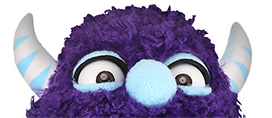The History of Halloween Costumes
By: FUN Monster
Celebrating Halloween can be a fun time as you choose just the right costume for a party or trick-or-treating. When Halloween comes around at the end of October, summer is long gone and you are probably beginning to look ahead to fall and winter holidays. Although Halloween is an exciting time of costumes, trick-or-treating, and parties, this holiday didn't always have a festive theme. Long ago, people used to wear costumes and make big bonfires because they were trying to scare ghosts away that they thought came out on this night.
The History of Halloween
Celtic people lived in Europe hundreds of years ago. The Celts used to celebrate the harvest coming and the end of the summer on November 1 every year. The Celts called their harvest festival Samhain. They believed that on the night before Samhain, ghosts would come out and wander around. Hundreds of years later, other religious beliefs spread through Europe where the Celtic people lived. Christian people celebrated All Saints' Day on the same day as Samhain was celebrated: November 1. Gradually, these celebrations blended together. People began observing All Hallows Eve on the night before All Saints Day.
Ancient Origin of Halloween
The word "Halloween" is a combination of smaller words. "Hallow" is another word for a saint, and "een" is a shortened form of the word "evening." Putting these two words together creates "hallow evening," or "Halloween." All Hallows Day or All Saints Day comes every year on November 1, so the night before would be All Hallows Eve, which is where the word Halloween came from.
Day of the Dead: Customs Around the World
The Day of the Dead is a festival celebrated on November 1 and 2. People in Mexico and other Latin American countries honor their dead during this festival. As people celebrate the Day of the Dead, they believe that they would be insulting the dead if they were sad. So instead, they celebrate with big parties and costumes. Many people set up altars in their homes to honor family members who have died. The altars might have candles, flowers, pictures, and favorite foods of the spirits. People also decorate the graves of dead family members, and they may share special stories about them.
Today's Halloween Traditions
Many of the ways people celebrate Halloween today have come from ancient traditions that people long ago had for Samhain, All Saints Day, and All Hallows Eve. The Celts carried lanterns on All Hallows Eve, which they made out of turnips. Later, instead of carrying turnip lanterns, people used pumpkins. This is where jack-o'-lanterns originated. The legend of the jack-o'-lantern comes from a man named Jack who wasn't able to enter either heaven or hell after he died because of tricks he played on the devil. Instead, Jack had to wander the Earth with a lantern. To ward off evil spirits, the Celts would set food out on their doorsteps, which is how trick-or-treating started. During Samhain, people used to light bonfires as a way of making sure that the sun would come back the following spring.
Costumes and Trick-or-Treating
The Celtic people's belief that ghosts wandered around on the night before Samhain is connected with the tradition of costumes on Halloween. To protect themselves from these spirits, the Celts would dress up in costumes. The Celts thought that if they disguised themselves to look like scary spirits, they would blend in with the real spirits who were wandering around. Modern trick-or-treating is a newer tradition. It wasn't until about a hundred years ago that trick-or-treating began as a way to get pranksters to stop damaging property on Halloween. Homeowners began setting out candy on their doorsteps to get tricksters to behave themselves.
Halloween Superstitions
Lots of different superstitions have a connection with Halloween. Black cats are symbols of bad luck. Years ago, when women used to be accused of being witches, people thought that pet cats were a part of their demonic power. Bats are also associated with Halloween and old witch hunts. People thought that bats were a sign of bad luck and a part of witches' powers. Even the orange and black colors of Halloween have a symbolic importance. Orange is a harvest color, and black is a color of death.
- History of Halloween
- Halloween History
- The History of All Hallows' Eve
- The Day of the Dead
- Halloween and Devil's Night: Linked Fates of Two Folk Festivals
- Where Does Halloween Come From? (PDF)
- History of Halloween (PDF)
- All Hallow's Eve (PDF)
- Halloween Origins and Traditions (PDF)
- Gangsters, Pranksters, and the Invention of Trick-or-Treating, 1930-60 (PDF)
- Little-Known Facts About Halloween (PDF)

